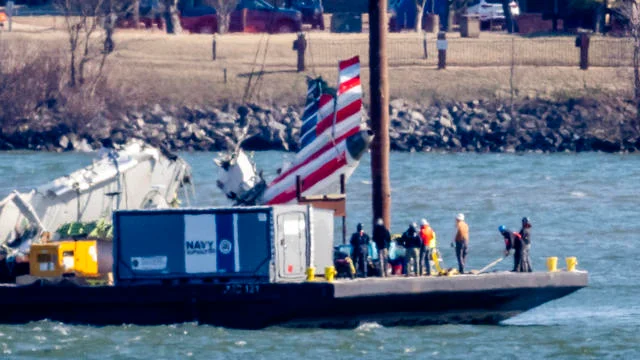The catastrophic collision between an Army Black Hawk helicopter and an American Eagle passenger plane over the Potomac River late last month has prompted intense scrutiny over aviation safety protocols, particularly concerning the use of critical tracking systems. All 67 individuals aboard both aircraft perished in the tragic incident near Reagan National Airport in Washington, D.C., making it one of the deadliest aviation accidents in recent U.S. history. Following a closed-door briefing with the Federal Aviation Administration (FAA) and the National Transportation Safety Board (NTSB), Senator Ted Cruz revealed that the Black Hawk helicopter had its Automatic Dependent Surveillance-Broadcast (ADS-B) system turned off during the flight. This revelation has raised questions about the decision-making processes surrounding the operation of military aircraft in civilian airspace.
Senator Cruz, a Texas Republican who chairs the Senate Commerce Committee with oversight of the airline industry, expressed grave concerns about the incident. He emphasized that while military aircraft are legally allowed to operate without the ADS-B system for national security reasons, this particular flight was a routine training mission, and there appeared to be no compelling justification for disabling the system. Cruz stated that the ADS-B system, which provides precise, real-time tracking data far more detailed than traditional radar, could have played a crucial role in preventing the accident. Although the helicopter’s transponder was active—allowing it to appear on radar screens—the absence of ADS-B significantly reduced the level of detailed tracking available to air traffic controllers.
Senator Tammy Duckworth, a former Army helicopter pilot and current member of the Senate Commerce Committee, also raised concerns about the incident. She pointed out the uncertainty surrounding whether the Black Hawk’s ADS-B was operational or even turned on during the flight. According to Duckworth, the Army confirmed that the ADS-B equipment was installed on the helicopter, but NTSB investigators have not yet verified if it was functional at the time of the collision. NTSB Chair Jennifer Homendy acknowledged that investigators are still working to determine if the Black Hawk was equipped with the technology and whether it was in use. She explained that the helicopter crew was conducting a combined night vision goggle annual check ride, which involves complex maneuvers under challenging conditions, potentially increasing the risk of such an incident.
Air traffic control records revealed that the controller handling the flight had a radar track on the Black Hawk, showing it flying at an altitude of approximately 300 feet. The controller maintained communication with the helicopter crew, who confirmed they had visual contact with the American Eagle plane and would maintain proper separation. Despite these assurances, the collision occurred, raising serious concerns about potential lapses in situational awareness, coordination, and decision-making both in the cockpit and in the control tower. The absence of ADS-B data, which provides enhanced situational awareness, may have contributed to a failure to fully assess the proximity and trajectory of the two aircraft.
Senator Maria Cantwell, a Democrat from Washington, questioned why the FAA permits military flights to operate in civilian airspace without the ADS-B system, particularly when these flights pose potential risks to commercial aviation. Cantwell’s concerns highlight the broader issue of integrating military and civilian aviation operations in shared airspace, especially in congested areas like the Washington, D.C. metropolitan region. The FAA’s policy, which allows military aircraft to disable ADS-B for security reasons, may need to be reevaluated to prevent similar tragedies in the future.
The NTSB’s investigation is focused on several critical questions: Was the ADS-B system present on the Black Hawk? If so, was it turned on, and if not, why? Investigators are also examining whether the use of ADS-B could have helped prevent the collision. Preliminary findings suggest that even without ADS-B data, there was sufficient radar and communication information available to identify the potential for a collision. This raises additional concerns about whether procedural errors, miscommunication, or human factors played a role in the accident.
The tragedy has sparked a broader debate within the aviation community and among policymakers about the need for stricter regulations governing military operations in civilian airspace. Aviation safety experts argue that while national security considerations are important, they must be balanced against the safety of commercial flights and the general public. Some are calling for mandatory use of ADS-B in non-combat situations, especially during training missions, to enhance situational awareness and reduce the risk of mid-air collisions.
Families of the victims, along with the general public, are demanding transparency, accountability, and swift action to address the safety gaps highlighted by this incident. The outcome of the NTSB’s investigation is expected to influence future aviation policies, potentially leading to changes in how military and civilian flights are coordinated. Lawmakers are likely to introduce new legislation aimed at closing regulatory loopholes and ensuring that critical safety technologies are utilized consistently, regardless of the type of aircraft involved.
As the investigation continues, the aviation industry, military officials, and government regulators face mounting pressure to provide clear answers and implement reforms that will prevent similar tragedies in the future. The loss of 67 lives serves as a stark reminder of the importance of rigorous safety protocols and the need for constant vigilance in maintaining the highest standards of aviation safety.
Stay ahead with the latest news on global innovation, leadership, entrepreneurship, business, and tech. Join us on WhatsApp or Telegram for real-time updates. Have a report or article? Send it to report@theinnovationtimes.com.
Follow us on X (Twitter), Instagram, LinkedIn, YouTube, Pinterest and Facebook for more insights and trends



